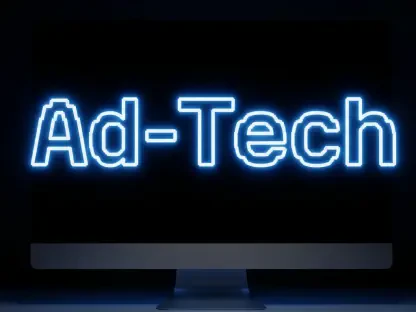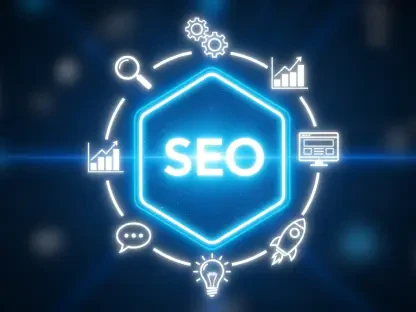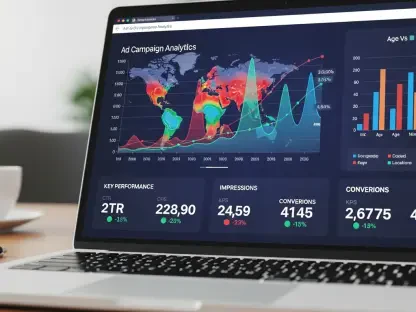As digital marketing emerges as a pivotal arena for businesses globally, the transformative dynamics in this domain demand that marketers remain agile and forward-thinking to maintain their competitive edge. With the advent of 2025, technological advancements, evolving privacy concerns, and shifting consumer behaviors have converged, fundamentally reshaping the digital marketing landscape. The accelerated integration of Artificial Intelligence (AI) in content creation, the evolution of search engine optimization strategies, and heightened emphasis on data privacy and first-party data collection are not just trends but imperatives for adaptation. Businesses must navigate these complex elements to remain relevant and effectively engage consumers in a rapidly changing market. This discussion delves into significant advancements shaping digital marketing today, providing a clear roadmap for businesses aiming for success in the ever-evolving digital ecosystem.
The Ascension of AI-Powered Content Creation
The integration of AI into content production has radically transformed how businesses craft and disseminate information, proving indispensable in augmenting speed, personalization, and efficacy. Tools such as ChatGPT, Jasper, and Copy.ai have become ubiquitous across industry verticals, with more than seventy percent of businesses relying on these technologies to generate dynamic and targeted content. AI-driven content creation allows for rapid iteration and A/B testing, facilitating enhanced targeting and greater return on investment. Yet, as integral as AI is, preserving the human element remains crucial. Ensuring editorial oversight enables brands to maintain authenticity and credibility, aligning AI-generated text with the established voice and persona of the brand.
Despite the efficiencies AI introduces, it is imperative for businesses to ensure that content not only meets technical accuracy but also resonates emotionally and intellectually with audiences. Balancing the analytic precision offered by AI tools with creativity and empathy imbues content with a humanity that purely algorithmic outputs could lack. Maintaining this balance indicates a brand’s commitment to delivering value beyond mere information, fostering deeper connections with its audience in a landscape crowded with automated content. This strategic combination of AI and human creativity equips businesses to meet diverse consumer expectations, paving the way for more meaningful interactions and sustained customer loyalty.
Evolving Search Strategies: Zero-Click, Voice Search, and Beyond
The realm of search engine optimization is undergoing a profound transformation, driven by innovations like zero-click search and the increasing prevalence of voice-activated search technologies. The rise of tools such as Google’s Search Generative Experience (SGE) and platforms like Perplexity AI marks a shift away from traditional SEO practices. Users now receive instantaneous, direct answers to queries, diminishing the need to explore linked web pages. As a result, marketers must adapt by optimizing content for featured snippets and AI-driven responses. Elevating brand visibility through strategic mention optimization and structured data implementation has become crucial. Developing content clusters via internal linking further enhances a site’s authority and relevance.
Simultaneously, the maturation of voice search, propelled by devices including Alexa, Google Nest, and Siri, signals a shift in consumer search behavior. Voice searches tend to be conversational and contextually driven, requiring a shift to more natural language optimization strategies. Long-tail keywords and FAQ sections have become essential to capturing voice-activated queries effectively. Embracing a mobile-first approach, ensuring rapid page load times, and maintaining up-to-date local listings are critical components of a comprehensive search optimization strategy. These efforts bolster a brand’s discoverability, positioning it to capitalize on the growing preference for hands-free technology interactions among consumers. In this dynamic environment, adapting search strategies to embrace technological advancements enhances a brand’s relevance and accessibility.
The New Data Paradigm: First-Party Data and Privacy Protocols
In an environment increasingly governed by stringent privacy regulations, first-party data has emerged as an essential asset for businesses seeking to understand and engage their audiences. The phasing out of third-party cookies necessitates the adoption of direct data collection methods, enabling businesses to gather, segment, and leverage insights without reliance on intermediaries. By investing in Customer Relationship Management (CRM) systems, implementing gated content, and encouraging opt-ins, businesses can cultivate robust and ethical data-gathering ecosystems. This first-party data facilitates targeted marketing efforts while complying with rigorous privacy protocols, enhancing the brand-consumer relationship.
To effectively utilize first-party data, businesses must craft compelling lead magnets—including whitepapers and checklists—and employ intent-based segmentation. The seamless integration of this data into platforms like HubSpot, Klaviyo, or Segment enables businesses to create tailored communications that resonate with target audiences. Ethical data collection practices, underscored by clear consent mechanisms and transparent opt-out options, are paramount in maintaining consumer trust. Adhering to privacy-first marketing strategies and embracing ethical AI principles allows businesses to navigate regulatory landscapes effectively. Commitment to transparency and ethical practices reinforces brand integrity, setting businesses apart in a competitive market where data-driven insights and consumer trust are invaluable commodities.
The Unyielding Rise of Short-Form Video and No-Code Martech
Short-form video content continues to dominate digital landscapes, capturing audience interest with its engaging and concise format. Platforms like Instagram Reels, TikTok, and YouTube Shorts have seen exponential growth, reflecting consumer preferences for dynamic and easily digestible content. These videos, noted for generating substantially higher engagement than static posts, have become focal points for businesses aiming to maximize reach and impact. Formats such as “how-to” guides, behind-the-scenes insights, and user testimonials deliver meaningful engagement through visual storytelling. Repurposing existing content into vertical video formats using tools like CapCut or InVideo amplifies visibility, bridging the gap between long-form narratives and consumer attention spans.
Simultaneously, the proliferation of no-code Martech tools signals a democratization of digital marketing processes. Platforms such as Webflow, Make.com, and Piwik PRO empower marketers with limited technical expertise, reducing dependency on developers for creating landing pages, automating processes, and building advanced analytics dashboards. This shift enables marketers to innovate and experiment with agility, meeting emerging demands with flexibility and speed. The capacity to rapidly iterate campaigns, coupled with enhanced control over marketing operations, positions businesses to effectively harness consumer insights and navigate the complexities of the digital marketing realm. As the landscape continues to evolve, mastering short-form video and leveraging no-code tools are essential strategies for sustained success and growth.
Adapting to Change: Prioritizing Privacy and Ethical AI
The incorporation of AI into content production has significantly altered how businesses create and share information, enhancing speed, customization, and effectiveness. Tools like ChatGPT, Jasper, and Copy.ai have become widespread across various industries, with over seventy percent of businesses leveraging these technologies to produce engaging and targeted content. AI-powered content creation allows for quick iterations and A/B testing, improving targeting strategies and boosting return on investment. However, while AI is essential, maintaining a human touch is vital. Editorial oversight helps brands ensure the authenticity and reliability of content, aligning AI-generated material with the brand’s established voice and personality.
Despite AI’s efficiencies, businesses must ensure content not only achieves technical precision but also connects with audiences on an emotional and intellectual level. Balancing analytic precision with creativity and empathy brings a human touch to content that AI alone might lack. This balance reflects a brand’s dedication to providing value beyond basic information, fostering deeper ties with its audience amid a sea of automated content. By combining AI and human ingenuity, businesses can meet diverse consumer expectations, fostering meaningful interactions and promoting lasting customer loyalty.









